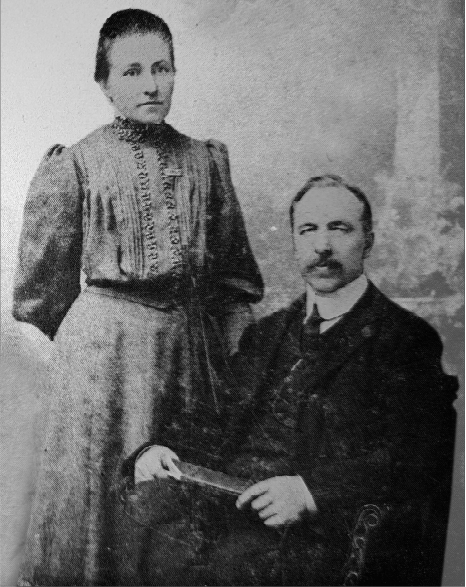(1795-1853)
Herbert Handley Bird was one of the pioneers in the dissemination of the gospel in the Indian subcontinent. He would proudly wear sandwich boards proclaiming the gospel, and was responsible for the salvation of several thousands.
Herbert Handley Bird was one of the pioneers in the dissemination of the gospel in the Indian subcontinent. He would proudly wear sandwich boards proclaiming the gospel, and was responsible for the salvation of several thousands.
His Roots and Salvation
Herbert Handley Bird was born in 1867 into a God-fearing and devout family headed by Mr. C. J. Bird who was an Anglican clergyman with evangelical outlook. He left the Anglican Church with several others to protest against the Romanising influences in high places. All five of Mr. and Mrs. Bird’s children gave their lives to the Lord’s service and went to far-flung places to preach the gospel. Florence and Handley came to India, Howard to China, and Cyril and Mary to Africa.
An account of the death of Archibald Bell seems to have been instrumental in the beginning of God’s work in Handley Bird’s soul.
As a schoolboy, Handley was mischievous like his comrades. One day, he supposedly acquired some fireworks and placed them in the double piano stool the class teacher used as a seat and some minutes after the class, the fireworks went off! Evidently known as a leader in mischief the headmaster immediately called out ‘Bird, come here!'
Boy Preacher
Handley began preaching in public while still at school and in his late teens he immigrated to America. He spent a short period in the Buffalo area of New York and then moved to Canada, where he did a lot of preaching in the North West. Sometimes, his funds would come to an end and he would hire himself out as a hand on a farm or elsewhere. His stay in Canada lasted for about four years.

Call to the Mission Field
When Herbert Handley Bird was 21 years of age in 1888, he responded to the Master’s call and set sail for India responding to the request of Mr. Robert Stanes, a businessman in Coimbatore. About a year later, his fiancée Miss Marion L. Miller joined him and they were happily married. They made Coimbatore their base for 11 years and became parents to two sons and two daughters, out of whom Carol, a bright unselfish young Christian, passed away in 1906 at the age of 13.
In the period of 1888 -1900, unprecedented famine conditions struck Gujarat, Rajputara and the northwest area of the Godavari District, and Handley and Marion Bird joined Florence and others in providing relief.
At Coimbatore, Handley discovered the problems attached to conversion from other religions. In 1891, for example, Appu Rao, a youth of 17, who had been converted was asked to be baptized. This resulted in the apprehension of Mr. Bird on the charge of kidnapping the boy, when the judge ordered the boy to be returned to his family. Appu Rao was brutally maltreated by his family, being beaten, drugged, chained, and imprisoned. Mr. Bird was released on the order of the Britsh Parliament (whose court transcripts can still be found online), and Rao was later baptized and became a faithful witness of Christ.
Handley Bird never stayed in one place for too long. He did a good deal of itinerant preaching in the southern parts of Tamil Nadu and Kerala. At the turn of the century, he visited Malabar and Travancore (now Kerala). A revival broke out and many were brought to the Lord from the Marthoma, Jacobite, and C.S.I. denominations. Later, a few of them left their Syrian churches and gathered together to worship the Lord in the New Testament pattern.
V. Nagel, who left Basel Mission adopted the New Testament pattern from Handley Bird and got baptized by him at Coimbatore. It was V. Nagel who started the first brethren assembly in the year 1897 at Kunumkulam, in the Malabar region of Kerala state. During the same period P E Mamman, a Marthomite priest, came all the way from Kumbanad to Kunnamkulam and Handley Bird baptized him. In the year 1899, P E Mammen along with three others gathered together to break the bread at Kumbanad. This was the first breaking of bread meeting in the Travancore region. Handley Bird and V. Nagel were of great help in teaching and guiding these believers who came out of denominational churches.
Tabernacle Preacher
Of all his ministries, some of the most remembered are the ones which led to him to be called the 'Tabernacle Preacher'. The model, made in China and Burma to Mr. Bird’s exact specifications, was one of the best of its kind according to many as it served well to portray the meaning behind its symbols. It attracted and drew several nonassembly goers to Mr. Bird’s gatherings too. As of 1986, the model was in the possession of Mr. C. N. C. Jayawardene of Colombo.
Travels Abroad
Mr. Bird left with his wife in 1912 on account of the latter’s illness. After some time he returned alone and had a touring ministry till 1914 in places like Singapore, China, and Russia. Mr. Bird was in Hong Kong when he received news of his wife’s illness. She recovered for a while and they continued in England until August 1922, when she went to be with the Lord. During his stay in England, through the years of the 1st World War, Mr. Bird was able to minister the Word in different parts of England, Scotland, and Ireland.
The Hostel
After Mrs. Bird’s death, Handley returned to India and spent some time in Cochin. His intention at that time was to stay there and he had even paid £300 as the down payment for a house there, but he was led to Madras where he moved to 17 Broadway, Ramkoti in Flower Bazaar.
The first floor of the house at Ramkoti was used as an assembly hall for the gathering of believers present in those days, and the rest of the building was used as a hostel for young men mainly from Kerala with the exception of one room on the roof for Mr. Bird’s residence.
Several of these young men grew up to be great teachers and ministers of the faith themselves under the able guidance of Mr. Bird. He would call them his boys and took care of them like his own sons.
During an outbreak of cholera, he personally cleaned the toilets and latrines to protect his young brethren from contracting the disease. Although he was a cultured and dignified man, he paraded round the streets of Madras with sandwich boards bearing gospel texts. The hostel proved to be an extremely conducive environment for the spiritual growth. It provided spiritual nourishment to many with daily indoor meetings, open air activities, preaching, distribution of tracts, and counselling. Out of these, a series- ‘Bible classes from Genesis to Revelation’ is one most remembered. Mr. Bird began the series for newly baptized members of the assembly and taught one chapter from the Bible daily beginning with chapter 1 of Genesis till the end of Revelation.
Due to the increasing number of members being added to the assembly, a larger hall was needed within few years. The constant strain was also taking its toll on Mr. Bird and he left for England in 1931 where he was told to rest.
The Meeting Room
But rest was not in Handley Bird’s dictionary. In 1932 he shifted to Bombay and with a few other believers gathered as an assembly in the house of Mr. McAfee, but this little assembly did not continue for long. In 1934, Mr. Bird acquired a flat and used it for assembly meetings. Within two years it became necessary to hire a hall to accommodate the assembly members. He called the young men he had trained in Madras and offered residential accommodation and spiritual guidance to these young men. Later they became the future elders of the assembly. He brought them together daily for biblical instruction, advice, counselling, and cared for their physical needs like securing employment for the unemployed. This concern for the needs both spiritual and physical set him apart a true follower of Christ.
Despite his age and increasing frailty he was an indefatigable open-air preacher and tract distributor and was seen walking the streets of the city frequently with sandwich boards bearing gospel texts. Even in his later years, his testimony bore fruit in many lives.
His Last Years
Handley refused to listen the advice to curtail his activities and undertook an extensive tour of India and Sri Lanka in 1933. However, it was becoming apparent that he could not continue his work in Bombay unaided. He invited Wilfred S. Durham from Bangalore to join him.
Mr. Bird left for Belgaum after being invited by Mr. William Irving, accompanied by his faithful companion Mr. Rayappa . He was a simple boy from Madras and his son-in-law Pastor Joseph later began the ‘New Life’ mission in Bombay.
Less than a week after his arrival at Belgaum, he was expected to speak in an afternoon meeting. Half an hour prior to the given time, Mr. Irving found him sitting on the side of his bed saying he was fainting. He did not speak again, but soon afterwards gave a cry and lost consciousness – an almost painless and instantaneous passing. He never did attend that meeting. He was called home on 27th May, 1938 at the age of 72.
He was laid to rest in the European cemetery near Sulge. Wilfred Durham, on whom the mantle of responsibility for the believers in Bombay fell, wrote, 'The saints in Bombay were deeply affected by the news and nearly a hundred gathered in the meeting room to mark the passing of God’s servant. Many were in tears but a note of triumph prevailed…'
Bibliography
1. H. Handley Bird - Missionary- Pioneer saint and a Great Heart compiled by T G Samuel & Justus Samuel (published by The Gospel Fellowship Trust of India, Madras).
2. Wings for Christ: The life of Handley Bird by Michelle Sunny Parayil, Harvest Times Vol. 11 Issue 08 August 2014.
3. 60 Years after Handley Bird - (1934-1994) Published by Christian Brethren Assembly, Fort Assembly, Mumbai
This article first appeared in the Harvest Times magazine in the August 2014 edition.


